23 Ways to Balance Corporate Directives With Local Customer Needs
Balancing corporate directives with local customer needs is a challenge many businesses face in today's globalized market. This article explores various strategies to achieve this balance, drawing on insights from industry experts and seasoned professionals. From adapting pricing to local seasonal rhythms to customizing amenities for specific events, these practical approaches can help companies thrive in diverse markets while maintaining brand consistency.
- Adapt Pricing to Local Seasonal Rhythms
- Tailor Messaging to Regional Preferences
- Localize Brand Presentation for Stronger Engagement
- Offer Personal Consultations in Older Neighborhoods
- Craft Community-Focused Messages for Rural Markets
- Extend Timelines During Natural Disasters
- Prioritize Personal Approach During Uncertain Times
- Assess True Value in Overlooked Markets
- Connect Military Families with Local Resources
- Highlight Certainty Over Speed for Retirees
- Incorporate Hyper-Local Insights into Property Valuation
- Empower Local Teams to Make Independent Decisions
- Create Flexible Closing Options for Probate
- Emphasize Practical Benefits in Transitioning Neighborhoods
- Preserve Sentimental Value in Home Sales
- Shift to Discreet Outreach in Vegas
- Offer Estate Cleanouts for Inherited Properties
- Provide Relocation Assistance for Mobile Homeowners
- Customize Amenities for Golf Tournament Guests
- Use Authentic Local Imagery for Marketing
- Partner with Movers for Foreclosure Situations
- Recommend Climate-Appropriate Roofing Materials
- Adapt Communication Styles to Cultural Preferences
Adapt Pricing to Local Seasonal Rhythms
Corporate guidelines once required a standardized pricing model across all markets. In our region, that created friction because seasonal cash flow patterns differed from the assumptions built into headquarters' model. Local families tended to have tighter budgets during the spring agricultural lull but were more flexible in late summer. Rather than pushing the flat structure, we introduced an installment plan aligned with those seasonal rhythms while still meeting corporate revenue targets.
The adjustment reduced delinquency rates by 18 percent in the first year and improved customer retention because families felt the business understood their reality. Presenting those outcomes with clear data helped corporate leaders see that flexibility at the local level strengthened loyalty without undermining broader goals. It was a case where respecting local conditions turned a rigid directive into a sustainable practice.

Tailor Messaging to Regional Preferences
I balance corporate directives with local customer needs by closely analyzing regional behavior and adapting strategies without compromising core company goals. For example, in one market, our standard promotional email campaigns weren't resonating; open rates were far below expectations. After reviewing local engagement data and conducting a few customer interviews, I adjusted the messaging to reflect local preferences and cultural nuances while keeping the campaign aligned with corporate branding. The results were immediate—open rates increased by 35%, and click-throughs doubled within the first two weeks. This experience taught me that small, thoughtful adjustments tailored to local audiences can significantly enhance results, even when working within strict corporate guidelines. By combining data-driven insights with a deep understanding of local preferences, I've been able to maintain brand consistency while achieving stronger engagement and customer satisfaction in diverse markets.

Localize Brand Presentation for Stronger Engagement
Balancing corporate directives with local customer needs often comes down to treating "guidelines" as a foundation rather than a ceiling. Corporate wants consistency and scale, while customers want relevance and recognition. The sweet spot is making sure the brand feels familiar everywhere but personal in each market.
One example that stands out was a rollout of seasonal displays for a product line. The corporate directive was a uniform layout with identical visuals and messaging across all locations. It looked great in flagship stores, but in one suburban market, foot traffic was slower and customers tended to shop with families. The sleek, minimalist layout didn't resonate—it felt cold and unapproachable. Instead of scrapping the directive, we adapted. We kept the corporate visuals but localized the presentation: we added lifestyle signage featuring families, rearranged displays to make products more touchable, and built a small "try it" area that encouraged interaction.
The results were immediate. Engagement with the display nearly doubled, and sales in that category outperformed other locations following the strict template. Interestingly, customers mentioned in feedback that they felt the display "spoke to them" more, even though the core branding was the same.
The key insight was that localization doesn't mean going rogue—it means translating intent into context. Corporate gave us the story they wanted to tell; we just told it in a dialect that fit the local audience. By sharing the results back up the chain, corporate also saw the value in flexibility, and those localized tweaks later became best practices rolled out across other markets.
What I learned is that the strongest brands don't sacrifice consistency for local nuance—they learn to layer them. Customers don't care if a campaign is perfectly on-brand; they care if it feels relevant to their lives. When you get that balance right, both corporate and the customer win.
Offer Personal Consultations in Older Neighborhoods
I balance broader business strategies with local needs by drawing on my teaching background to truly listen to each homeowner's unique situation. For example, when working in older neighborhoods near downtown, I noticed many sellers were overwhelmed by the traditional listing process and needed more hand-holding than our standard protocols suggested. So I started offering free consultations where I'd sit down with families for an hour, explain their options in plain English, and connect them with local resources even if they weren't ready to sell immediately. This personal touch led to a 50% increase in referrals from that area because word spread that we actually cared about helping people, not just closing deals.

Craft Community-Focused Messages for Rural Markets
I've learned that running a virtual operation from Arizona while serving North Carolina requires me to think beyond standard corporate protocols and really understand each local market's personality. For instance, when I noticed our SMS campaigns weren't resonating in rural areas outside Charlotte, I discovered these homeowners preferred more personal, story-driven messages that acknowledged their community ties rather than our typical direct-offer format. By adjusting our messaging to reference local landmarks and using phrases like 'helping neighbors' instead of corporate jargon, we increased our response rates by 35% in those markets because sellers felt we understood their small-town values, even though we were operating remotely.

Extend Timelines During Natural Disasters
I balance our core business model with local Alabama and Florida market needs by staying flexible on timelines while maintaining our cash-buying advantage. For example, when Hurricane Sally hit our Mobile area in 2020, instead of sticking to our standard 7-day closing process, I personally extended timelines and helped displaced families coordinate temporary housing while we handled their storm-damaged properties. This approach not only helped 18 families during a crisis but also strengthened our reputation--local insurance agents started referring clients directly to us because they knew we'd prioritize people over quick profits, ultimately increasing our referral business by 60% in that region.

Prioritize Personal Approach During Uncertain Times
I've learned that truly serving our local North Alabama community means understanding their specific concerns, even if it deviates from a standard corporate script. For example, during the initial COVID-19 lockdown, while national real estate trends focused on virtual tours, I recognized that many local homeowners, especially those older or less tech-savvy, felt isolated and preferred a more personal, albeit safe, approach. We adapted by offering drive-by property assessments and masked, socially distanced outdoor consultations, which significantly increased our engagement and sales with this demographic because we prioritized their comfort and safety over strictly virtual processes, showcasing our commitment to honesty and integrity even in uncertain times.

Assess True Value in Overlooked Markets
I balance corporate directives by treating each mortgage note as a deeply personal story that demands tailored solutions--especially in overlooked rural markets. In one case, a Wyoming rancher needed urgent cash flow but faced appraisal challenges for his remote property note; I bypassed strict protocols by personally assessing its true agricultural value and closing above market rate within days. That rare win-win generated twelve referrals from his tight-knit community alone because we proved capable where robotic national models fail.

Connect Military Families with Local Resources
Being a Wilmington native gives me insight into our coastal lifestyle that no corporate manual could teach--like how our military families at Camp Lejeune often get orders with just weeks' notice. I remember one Marine family who needed to sell quickly but couldn't afford repairs after their roof leaked during a winter storm. Instead of following our standard 'as-is' protocol, I connected them with my network of local contractors who agreed to defer payment until closing, allowing us to present a move-in ready home that sold for $15,000 more than expected and gave this family the financial cushion they desperately needed for their cross-country move.

Highlight Certainty Over Speed for Retirees
In Las Vegas, I've found that the standard corporate playbook usually emphasizes speed, but our local sellers often place just as much value on certainty. For example, when working with retirees downsizing from longtime homes, I shifted away from marketing only fast closings and instead highlighted guaranteed purchase offers with flexible move-out dates. That small adjustment made sellers far more comfortable, and it directly led to an uptick in referrals because we were viewed as genuinely understanding the local lifestyle transition.

Incorporate Hyper-Local Insights into Property Valuation
For us at Michigan Houses for Cash, balancing corporate directives with local needs means prioritizing communication and flexibility. A prime example is our approach to property valuation; while corporate models provide a baseline, I always insist on having a team member physically walk through every property and engage with neighbors to understand the micro-market. For instance, in one Detroit neighborhood, the initial corporate valuation didn't account for a recent community garden initiative that significantly boosted local appeal. By adjusting our offer based on that hyper-local insight, we secured the property, fostering goodwill in the community and increasing our eventual resale value by 15% due to the enhanced neighborhood desirability we recognized firsthand.

Empower Local Teams to Make Independent Decisions
For us, "corporate directives" are much more personal. They represent our overarching business strategy. The issue was that our general growth strategy didn't always align with the specific needs of our local customers. Our local customers had very particular requirements that our broad strategy was overlooking.
We addressed this balance by empowering our local team to make decisions independently. The key is to trust the people on the ground who interact with our customers daily.
A prime example is a customer who had a small but recurring issue with a specific part. Our general strategy would have been to simply sell them a new one. However, our local operations team understood the customer's frustration. They made a localized adjustment. Instead of selling a new part, they provided the customer with a simple, specific solution that directly resulted from their operational expertise. They assisted in fixing the part rather than selling a replacement.
This single decision had a significant impact. The customer was so appreciative of the help that they became our strongest advocate. We learned that our general strategy serves merely as a guide. The real work is accomplished by the people on the ground.
My advice is straightforward: the best way to balance a general strategy with the unique needs of your local customers is to empower your local team to make decisions independently. Trust the people on the ground. They are your eyes and ears in the market, and they are the ones building relationships. When you give them the autonomy to make decisions, you give them the opportunity to make a difference.

Create Flexible Closing Options for Probate
For me, the balance comes from remembering that real estate isn't just a transaction--it's someone's life transition. For example, corporate best practices usually push for the fastest possible closing, but in Reno, I found many families going through probate needed more time and support. By creating a flexible closing option and personally walking families through each step, not only did we reduce stress for sellers, but referrals tripled because word spread that we genuinely cared about people, not just properties.

Emphasize Practical Benefits in Transitioning Neighborhoods
I've learned that success in real estate comes from deeply understanding each neighborhood's unique dynamics rather than applying a one-size-fits-all approach. For example, when I started flipping properties in a historically working-class area that was gentrifying, my initial corporate-style marketing focused on high-end finishes and luxury features. Sales were sluggish until I pivoted to emphasizing practical benefits like energy efficiency, low maintenance costs, and proximity to public transit - what the actual buyers in that area valued most. That simple shift in messaging and property positioning increased my flip turnaround time by 40% and helped me build lasting relationships with local real estate agents who knew I understood their clients' real needs.

Preserve Sentimental Value in Home Sales
For me, balancing corporate directives with the needs of our local Augusta customer base comes down to truly listening, which is something I learned early on while flipping houses fresh out of college in Hephzibah and Martinez. For instance, while typical corporate advice pushes for optimizing every square foot for maximum resale, I found that many local families selling their childhood homes prioritized preserving certain features or heirlooms. By offering flexible sales agreements that allowed them to take their time with sentimental items, rather than forcing a quick, sterile clear-out, we built immense trust. That small adjustment led to a noticeable increase in referrals, as people saw we genuinely cared about their transition, not just the transaction.

Shift to Discreet Outreach in Vegas
Growing up in Las Vegas taught me that what works in other markets doesn't always work here, so I make a point of listening to local sellers before applying any corporate-style process. For example, after learning that many Vegas homeowners preferred a private, low-stress sale over flashy advertising, I shifted our outreach from broad marketing to personalized, discreet outreach and saw our response rate double almost overnight. That adjustment not only earned us more trust but also built long-term relationships that led to consistent referrals from people who felt genuinely understood.

Offer Estate Cleanouts for Inherited Properties
I've found that the key is treating every homeowner's situation individually, much like my parents did with tenants. For example, when corporate templates suggested quick closings for inherited properties, we noticed Springfield families needed time to process emotions - so we started offering free estate cleanouts and flexible timelines. This adjustment led to a 30% increase in referrals from local attorneys because we honored the community's grieving process while still meeting business goals.

Provide Relocation Assistance for Mobile Homeowners
For me, balancing big-picture strategy with local needs comes down to empathy and observation. For example, while standard investor playbooks push for fast cash offers, I noticed many Charleston mobile home owners were more worried about where they'd go next. By adding relocation assistance--sometimes even helping families secure their next home--we not only eased their stress but also saw more deals close smoothly and got a steady stream of word-of-mouth referrals because people felt we genuinely had their back.

Customize Amenities for Golf Tournament Guests
I bridge corporate efficiency with local needs by applying my restaurant background's guest-first mentality to real estate. For example, while corporate suggested standard amenities for my Augusta National Airbnbs, I noticed Masters Tournament guests wanted golf-focused experiences. As a result, I installed backyard putting greens and curated local course guides. This hyper-local touch increased our premium pricing by 20% during tournament weeks and generated 40% repeat bookings from golf enthusiasts.

Use Authentic Local Imagery for Marketing
The fashion retailer we worked with followed international brand standards, which emphasized polished, high-gloss visual content. However, the Marseille customer segment preferred authentic street-style images over polished content because they wanted to see real authenticity. We obtained permission from HQ to run A/B tests using unfiltered street photography taken at Marseille skate parks. The Instagram engagement rates increased by 40% after we introduced authentic street photography, and the Marseille store experienced increased customer traffic shortly after. The most effective approach sometimes requires moving away from polished content to showcase genuine elements that exist in everyday life.
Partner with Movers for Foreclosure Situations
For me, the balance comes down to listening closely to what homeowners are really going through and adjusting beyond the standard playbook. For example, while the typical guidance is to push for fast closings, I found that many St. Louis families facing foreclosure needed help with relocation logistics first. By partnering with local moving companies and offering flexible closing dates, not only did we earn trust and referrals, but we also reduced last-minute deal fall-throughs by nearly half.

Recommend Climate-Appropriate Roofing Materials
Roofing material manufacturers also advertise certain products across the country, but sometimes they might not be suitable for specific areas. A good example involves dark-colored shingles. These are marketed as trendy and efficient, but during Charlotte's hot and humid summers, many homeowners were worried that they would trap heat.
Instead of finishing with the order, we started selling lighter reflective shingles that were still effective yet worked better with our climate. We explained how they could save cooling costs and keep homes cooler.
It created an immediate impact - customers were listened to and believed because we were no longer mass-selling the 'national recommendation.' We were offering a solution tailored for our region.
That's the balance: lead with knowledge of the industry, but always adjust due to what your community truly needs. Where you get the best results.

Adapt Communication Styles to Cultural Preferences
Balancing corporate directives with local needs requires understanding cultural nuances that impact customer interactions. After noticing communication challenges in our Latin American and East Asian markets, we trained our staff to adapt their communication styles to align with local preferences. For example, we shifted from using direct deadline language to a more suggestive approach, saying things like "To secure your preferred time, booking a bit earlier helps" instead of imposing strict cutoffs. This simple adjustment significantly reduced friction in customer interactions while still maintaining our corporate scheduling requirements.




